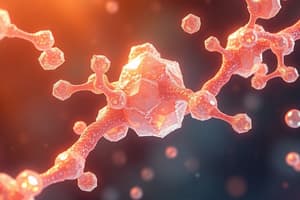Podcast
Questions and Answers
Quel est le nom donné au processus par lequel un aldéhyde réagit avec un alcool?
Quel est le nom donné au processus par lequel un aldéhyde réagit avec un alcool?
- Formation d'hémiacétal (correct)
- Hydratation
- Oxydation
- Éthérification
Qu'est-ce qui distingue les isomères D et L dans les monosaccharides?
Qu'est-ce qui distingue les isomères D et L dans les monosaccharides?
- Leur poids moléculaire
- Leur solubilité dans l'eau
- Leur configuration spatiale (correct)
- Leur formule chimique
Quel type de monosaccharide a quatre atomes de carbone?
Quel type de monosaccharide a quatre atomes de carbone?
- Pentose
- Triose
- Hexose
- Tétrose (correct)
Comment les enzymes différencient-elles les énantiomères du glucose?
Comment les enzymes différencient-elles les énantiomères du glucose?
Quel terme décrit la forme cyclique des glucides en solution?
Quel terme décrit la forme cyclique des glucides en solution?
Quel est le résultat du remplacement du groupe hydroxyle en C2 du mannose?
Quel est le résultat du remplacement du groupe hydroxyle en C2 du mannose?
Quel acide est le plus souvent utilisé pour réagir avec les glucides?
Quel acide est le plus souvent utilisé pour réagir avec les glucides?
Quelle forme de ribose est présente dans les nucléotides?
Quelle forme de ribose est présente dans les nucléotides?
Quel dérivé du glucose est formé par réduction au site CHO?
Quel dérivé du glucose est formé par réduction au site CHO?
Quel est le produit résultant de la cyclisation du glucose avec un OH en C1?
Quel est le produit résultant de la cyclisation du glucose avec un OH en C1?
Quel est le produit de l'oxydation du C1 et C6 du glucose ?
Quel est le produit de l'oxydation du C1 et C6 du glucose ?
Quelle est la désignation correcte pour une molécule à 5 carbones dans la nomenclature des cycles ?
Quelle est la désignation correcte pour une molécule à 5 carbones dans la nomenclature des cycles ?
Quelle forme de cyclisation du glucose est la plus stable et avec quel pourcentage ?
Quelle forme de cyclisation du glucose est la plus stable et avec quel pourcentage ?
Comment l'oxydase de glucose fonctionne-t-elle dans la détermination du taux de glucose ?
Comment l'oxydase de glucose fonctionne-t-elle dans la détermination du taux de glucose ?
Quel est l'état le plus oxydé du carbone ?
Quel est l'état le plus oxydé du carbone ?
Flashcards
Monosaccharides
Monosaccharides
Les sucres simples, qui ne peuvent pas être décomposés en sucres plus petits par hydrolyse.
Aldoses/Cétoses
Aldoses/Cétoses
Catégories de monosaccharides selon la présence d'un groupe aldéhyde (aldose) ou d'un groupe cétone (cétose).
Isomérie des sucres (énantiomères)
Isomérie des sucres (énantiomères)
Molécules avec la même formule chimique mais des structures spatiales différentes qui sont images miroir l'une de l'autre et non superposables.
Épimères
Épimères
Signup and view all the flashcards
Cyclisation des Monosaccharides
Cyclisation des Monosaccharides
Signup and view all the flashcards
Anomérie du glucose
Anomérie du glucose
Signup and view all the flashcards
Nomenclature des oses cycliques
Nomenclature des oses cycliques
Signup and view all the flashcards
Cyclisation du glucose (conformation)
Cyclisation du glucose (conformation)
Signup and view all the flashcards
Oxydation du glucose (C1)
Oxydation du glucose (C1)
Signup and view all the flashcards
Glucose oxydase
Glucose oxydase
Signup and view all the flashcards
Réduction du glucose
Réduction du glucose
Signup and view all the flashcards
Acétylation du glucose
Acétylation du glucose
Signup and view all the flashcards
N-acétyl manossamine
N-acétyl manossamine
Signup and view all the flashcards
Désoxyoses
Désoxyoses
Signup and view all the flashcards
Phosphorylation des glucides
Phosphorylation des glucides
Signup and view all the flashcards
Study Notes
Monosaccharides
- Carbohydrates are one-third of the important classes, along with proteins and lipids.
- Carbohydrates (sugars) are also known as saccharides or hydrates of carbon (CO and H).
- Simple sugars are classified as either aldoses (e.g., glyceraldehyde) or ketoses (e.g., dihydroxyacetone).
- They are classified by the number of carbon atoms (triose, tetrose, pentose, hexose).
- Chiral molecules, such as sugars, can rotate polarized light. D and L isomers are mirror images (enantiomers).
- Epimers have the same chemical properties but differ only in the configuration of a single chiral carbon atom.
Representation, Nomenclature, and Reactions
- Aldehydes and ketones can react with alcohols to form hemiacetals or hemiketals
- The resulting structure is cyclic, and the different forms are called anomers based on the position of the hydroxyl group on the anomeric carbon (e.g., alpha or beta).
Cyclization of Monosaccharides
- Intramolecular reaction between aldehyde & alcohol group.
- Cyclic form is favored in solution
- Two molecules with different properties=anomers
- Cyclization occurs around C1 to C5 creating a stable ring.
- Nomenclature: furanose (5-membered rings) or pyranose (6-membered rings) according to ring size.
Oxidation of Glucose
- Oxidized to form different acids, e.g., glucaric acid (C1 and C6 oxidation), gluconic acid (C1 oxidation), and glucuronic acid (C6 oxidation).
Osamines
- One example is an amino sugar resulting from the substitution of an alcohol group with an amine group.
- N-acetylglucosamine and N-acetylgalactosamine are examples
- These can be further conjugated with pyruvic acid.
Deoxyhexoses
- Important examples include L-rhamnose and L-fucose (resulting from the removal of an oxygen atom).
Reduction of Glucose
- Reduction occurs at the aldehyde group (-CHO)
- The product is Sorbitol or Mannitol.
Reactions of Osos with Acids
- All hydroxyl groups except the anomeric carbon are alcohols.
- Reaction between the hydroxyl groups and phosphoric acid results in phosphorylated sugars
Nucleotides
- Composed of ribose in its beta-D-ribofuranose form.
- C5 hydroxyl group is phosphorylated, and C1 is linked to a nitrogenous base (nucleoside)
- Phosphorylation of the nucleoside produces a nucleotide.
- Nucleotides are building blocks of DNA and RNA, and play roles in metabolic pathways as energy carriers (e.g., NAD+).
Fischer Projection
- It's a way to represent stereoisomers.
- Shown in the image are the different sugars and their possible isomer variations, both aldoses and ketoses.
Studying That Suits You
Use AI to generate personalized quizzes and flashcards to suit your learning preferences.




